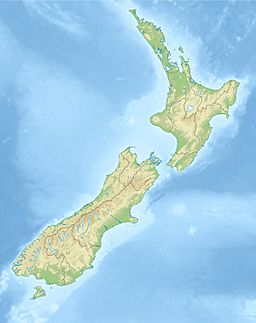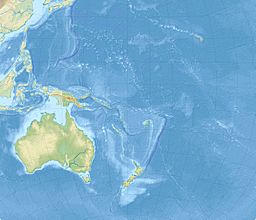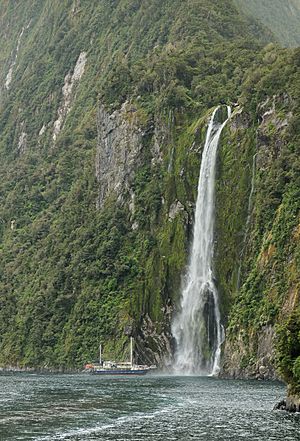Milford Sound facts for kids
Quick facts for kids Milford Sound |
|
|---|---|

Panorama of Milford Sound looking northwest from the township. Mitre Peak (centre) rises 1,692 m (5,551 ft) above the sound.
|
|
| Location | Fiordland, New Zealand |
| Coordinates | 44°38′53″S 167°54′20″E / 44.64806°S 167.90556°E |
| Native name | Piopiotahi (Māori) |
| Part of | Tasman Sea |
| River sources | Cleddau River, Arthur River, Harrison River |
| Max. length | 15.1 kilometres (9.4 mi) |
| Max. width | 1.94 kilometres (1.21 mi) |
| Surface area | 25 square kilometres (9.7 sq mi) |
| Max. depth | 291 metres (955 ft) |
Milford Sound (also known as Māori: Piopiotahi) is a beautiful fiord located in the southwest of New Zealand's South Island. It's part of the amazing Fiordland National Park and a World Heritage site called Te Wahipounamu. Many people think it's one of the best places to visit in the world. Some even call it the "eighth Wonder of the World"! You can usually reach Milford Sound by driving along State Highway 94, which ends at a small village also called Milford Sound.
Contents
What's in a Name? Milford Sound / Piopiotahi
Milford Sound / Piopiotahi has a special dual name. This means it has both a Māori name and a European name used together. This was decided in 1998 as part of an agreement with the Ngāi Tahu people. It shows how important the fiord is to both Māori and European New Zealanders.
The Māori Name: Piopiotahi
In the Māori language, the fiord is called Piopiotahi. This name comes from a bird called the South Island piopio. This bird, which looked a bit like a thrush, used to live in New Zealand but is now extinct.
According to a Māori legend, the hero Māui tried to make humans live forever. When he died, a single piopio bird flew to the fiord to mourn him. The name Piopiotahi means "one piopio," referring to this lonely bird.
The European Name: Milford Sound
The European name, Milford Sound, was given in 1823 by a sealer named John Grono. He named it after Milford Haven in Wales, which was his hometown. The Cleddau River, which flows into the fiord, also got its name from a river in Wales.
Geography: How Milford Sound Was Formed
Milford Sound is a type of valley called a fiord. It was carved out by huge glaciers over millions of years. The small village at the end of the fiord is also known as Milford Sound.
The fiord stretches about 15 kilometers (9 miles) inland from the Tasman Sea. It's surrounded by very steep rock faces that rise over 1,200 meters (3,900 feet) high!
Famous Peaks and Waterfalls
Some of the famous peaks here include The Elephant, which is 1,517 meters (4,977 feet) tall and looks like an elephant's head. Another is The Lion, which is 1,302 meters (4,272 feet) high and looks like a crouching lion.
Milford Sound has two waterfalls that flow all the time: Lady Bowen Falls and Stirling Falls. After heavy rain, many temporary waterfalls appear. They stream down the steep cliffs and can last for a few days.
Climate: A Very Wet Place
Milford Sound is one of the wettest places where people live in New Zealand, and even in the world! It gets about 6,412 millimeters (252 inches) of rain each year. Sometimes, it can rain as much as 250 millimeters (10 inches) in just one day!
This heavy rainfall creates dozens of amazing temporary waterfalls. Some of these falls are huge, dropping from a thousand meters high. Sometimes, the water makes parts of the rainforest slide down the cliffs into the fiord. You can see where the forest is growing back after these "tree avalanches."
Wildlife: Animals of Milford Sound
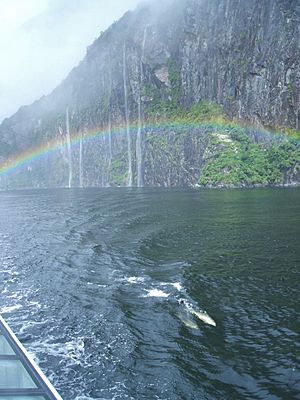
Milford Sound is home to many marine animals. You can often see seals here. It's also where you'll find the southernmost group of wild bottlenose dolphins. Sometimes, whales like humpbacks and southern right whales are seen more often now as their numbers are growing.
Penguins are also common in the sound. It's a special place where the Fiordland penguin breeds. Because of this, it's been named an Important Bird Area.
Unique Underwater World
The high rainfall in Milford Sound creates a special environment. The top layer of water is fresh water, stained brown by plants from the rainforest. This dark layer blocks sunlight. Because of this, deep-water creatures like Black coral can grow much closer to the surface than usual, sometimes as shallow as 10 meters (33 feet).
History: Discovering Milford Sound
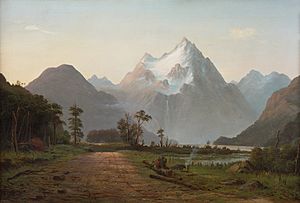
For a long time, European explorers didn't notice Milford Sound. Its narrow entrance made it seem like it didn't lead to a large bay. Sailors like James Cook also worried about getting too close to the steep mountains. They feared strong winds would trap their ships.
Before Europeans arrived, local Māori people knew the fiord very well. They understood the tides and where to find fish. Captain John Grono was the first European to discover it around 1812. He named it Milford Haven. Later, Captain John Lort Stokes changed the name to Milford Sound. In 1998, the official name became Milford Sound / Piopiotahi.
Even though much of Fiordland was not explored until the 1900s, Milford Sound quickly became famous for its beauty. This led to the discovery of the McKinnon Pass in 1888, which became part of the Milford Track. This track was one of the first walking trails for tourists. Later, the Homer Tunnel was built to allow road access to the fiord.
In 2006, only about 120 people lived in Milford Sound. Most of them worked in tourism or helped protect the environment.
Tourism: Visiting Milford Sound
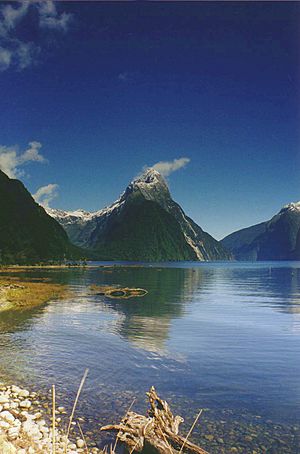
Milford Sound is a very popular place, attracting between 550,000 and 1 million visitors each year. Even though it's far away, many tourists come to see its beauty. Most visitors take a boat tour, which usually lasts one to two hours. Several companies offer these tours from the Milford Sound Visitors' Centre.
You can also go tramping (hiking), canoeing, and do other water sports. A few companies offer overnight boat trips. Most tourists only visit for the day and stay in nearby towns like Te Anau or Queenstown.
Underwater Observatory
At Harrisons Cove, on the north side of the fiord, you can visit the Milford Discovery Centre & Underwater Observatory. This observatory lets you see the unique underwater world of the fiord at a depth of 10 meters (33 feet). Because of the dark, fresh water layer, you can see deep-water animals like black coral growing close to the surface.
Milford Sound is also a stop for large cruise ships.
Getting to Milford Sound
Milford Sound is about 291 kilometers (181 miles) from Queenstown and 278 kilometers (173 miles) from Invercargill. Most tour buses leave from Queenstown. Some tourists also come from Te Anau, which is 121 kilometers (75 miles) away.
You can also take scenic flights by small planes or helicopters to and from Milford Sound Airport. The drive to Milford Sound is beautiful, passing through mountains and the 1.2-kilometer (0.75-mile) Homer Tunnel. This road can sometimes close in winter due to avalanches.
Because of the long drive, many tour buses arrive at Milford Sound around midday. This means it can get quite busy with many tourists and boats at the same time.
Environmental Incident
On February 8, 2004, about 13,000 liters (3,400 US gallons) of diesel fuel spilled in the fiord. This caused a 2-kilometer (1.2-mile) spill and closed the fiord for two days while a big cleanup effort took place.
Images for kids
-
Panorama of Milford Sound looking northwest from the township. Mitre Peak (centre) rises 1692 m above the sound.
-
Bottlenose dolphins swim under a rainbow.
-
Two swaggers boiling a billy of tea, Milford Sound by John Gibb, oil on canvas Christchurch 1886
-
Mitre Peak, towering over Milford Sound
See also
 In Spanish: Milford Sound para niños
In Spanish: Milford Sound para niños



